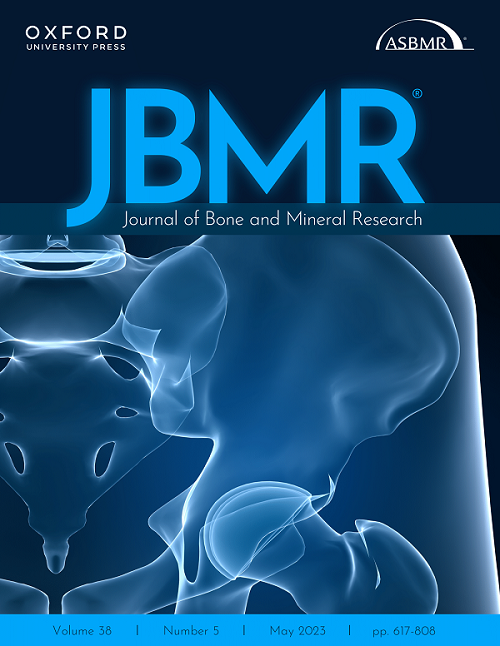Seong Hee Ahn, You Jin Lee, Seongbin Hong, Jung Wee Park, Ye Jhin Jeon, Bit-Na Yoo, Yong-Chan Ha, Jean Kyung Bak, Ha Young Kim, Young-Kyun Lee
求助PDF
{"title":"Risk of Fractures in Thyroid Cancer Patients With Postoperative Hypoparathyroidism: A Nationwide Cohort Study in Korea","authors":"Seong Hee Ahn, You Jin Lee, Seongbin Hong, Jung Wee Park, Ye Jhin Jeon, Bit-Na Yoo, Yong-Chan Ha, Jean Kyung Bak, Ha Young Kim, Young-Kyun Lee","doi":"10.1002/jbmr.4871","DOIUrl":null,"url":null,"abstract":"<div>\n \n <p>Postoperative hypoparathyroidism (PO-hypoPT) is an uncommon complication of total thyroidectomy in thyroid cancer patients. Although long-term hypoPT causes characteristic changes in bone metabolism, the risk of fractures in hypoPT remains inconclusive. We investigated the risk of fractures in Korean thyroid cancer patients with PO-hypoPT. This was a retrospective cohort study using data from the Korea Central Cancer Registry and Korean National Health Insurance Service. We analyzed 115,821 thyroid cancer patients aged ≥18 years, who underwent total thyroidectomy between 2008 and 2016. The risk of any fractures, including vertebral, hip, humerus, and wrist fractures, according to parathyroid function after total thyroidectomy, was analyzed using the multivariable Cox proportional hazard model. The PO-hypoPT and preserved parathyroid function groups included 8789 (7.6%) and 107,032 (92.4%) patients, respectively. Over a mean follow-up duration of 4.8 years, 159 (1.8%) and 2390 (2.2%) fractures occurred in the PO-hypoPT and preserved parathyroid function groups, respectively. The risk of any fractures was significantly lower in the PO-hypoPT group than in the preserved parathyroid function group (hazard ratio [HR] = 0.83; 95% confidence interval [CI] 0.70–0.98; <i>p</i> = 0.037) after adjusting for confounders. Regarding the fracture site, only the risk of vertebral fractures was significantly lower in the PO-hypoPT group compared with the preserved parathyroid function group (HR = 0.67; 95% CI 0.47–0.96; <i>p</i> = 0.028) after adjusting for confounders. Subgroup analyses showed that bone mineral density measurements and calcium supplementation interacted with the relationship between PO-hypoPT and the risk of any fractures (<i>p</i> for interactions = 0.010 and 0.017, respectively). PO-hypoPT was associated with a lower risk of fractures in thyroid cancer patients, especially at the vertebra. The relatively low bone turnover caused by PO-hypoPT and appropriate management for PO-hypoPT with active vitamin D and calcium may prevent the deterioration of skeletal health in thyroid cancer patients who can easily be exposed to long-term overtreatment with levothyroxine. © 2023 American Society for Bone and Mineral Research (ASBMR).</p>\n </div>","PeriodicalId":185,"journal":{"name":"Journal of Bone and Mineral Research","volume":"38 9","pages":"1268-1277"},"PeriodicalIF":5.1000,"publicationDate":"2023-06-20","publicationTypes":"Journal Article","fieldsOfStudy":null,"isOpenAccess":false,"openAccessPdf":"","citationCount":"1","resultStr":null,"platform":"Semanticscholar","paperid":null,"PeriodicalName":"Journal of Bone and Mineral Research","FirstCategoryId":"3","ListUrlMain":"https://onlinelibrary.wiley.com/doi/10.1002/jbmr.4871","RegionNum":1,"RegionCategory":"医学","ArticlePicture":[],"TitleCN":null,"AbstractTextCN":null,"PMCID":null,"EPubDate":"","PubModel":"","JCR":"Q1","JCRName":"ENDOCRINOLOGY & METABOLISM","Score":null,"Total":0}
引用次数: 1
引用
批量引用
Abstract
Postoperative hypoparathyroidism (PO-hypoPT) is an uncommon complication of total thyroidectomy in thyroid cancer patients. Although long-term hypoPT causes characteristic changes in bone metabolism, the risk of fractures in hypoPT remains inconclusive. We investigated the risk of fractures in Korean thyroid cancer patients with PO-hypoPT. This was a retrospective cohort study using data from the Korea Central Cancer Registry and Korean National Health Insurance Service. We analyzed 115,821 thyroid cancer patients aged ≥18 years, who underwent total thyroidectomy between 2008 and 2016. The risk of any fractures, including vertebral, hip, humerus, and wrist fractures, according to parathyroid function after total thyroidectomy, was analyzed using the multivariable Cox proportional hazard model. The PO-hypoPT and preserved parathyroid function groups included 8789 (7.6%) and 107,032 (92.4%) patients, respectively. Over a mean follow-up duration of 4.8 years, 159 (1.8%) and 2390 (2.2%) fractures occurred in the PO-hypoPT and preserved parathyroid function groups, respectively. The risk of any fractures was significantly lower in the PO-hypoPT group than in the preserved parathyroid function group (hazard ratio [HR] = 0.83; 95% confidence interval [CI] 0.70–0.98; p = 0.037) after adjusting for confounders. Regarding the fracture site, only the risk of vertebral fractures was significantly lower in the PO-hypoPT group compared with the preserved parathyroid function group (HR = 0.67; 95% CI 0.47–0.96; p = 0.028) after adjusting for confounders. Subgroup analyses showed that bone mineral density measurements and calcium supplementation interacted with the relationship between PO-hypoPT and the risk of any fractures (p for interactions = 0.010 and 0.017, respectively). PO-hypoPT was associated with a lower risk of fractures in thyroid cancer patients, especially at the vertebra. The relatively low bone turnover caused by PO-hypoPT and appropriate management for PO-hypoPT with active vitamin D and calcium may prevent the deterioration of skeletal health in thyroid cancer patients who can easily be exposed to long-term overtreatment with levothyroxine. © 2023 American Society for Bone and Mineral Research (ASBMR).
癌症术后甲状旁腺功能减退患者骨折风险的韩国全国性队列研究
术后甲状旁腺功能减退症(PO-hypoPT)是癌症甲状腺全切除术的一种罕见并发症。尽管长期低PT会引起骨代谢的特征性变化,但低PT骨折的风险仍不确定。我们调查了韩国癌症PO-hypoPT患者发生骨折的风险。这是一项回顾性队列研究,使用了韩国中央癌症登记处和韩国国家健康保险服务局的数据。我们分析了115821名年龄≥18岁的甲状腺癌症患者 年,2008年至2016年间接受了甲状腺全切除术。根据甲状腺全切除术后的甲状旁腺功能,使用多变量Cox比例风险模型分析任何骨折的风险,包括脊椎、髋关节、肱骨和手腕骨折。PO低PT组和保留甲状旁腺功能组分别包括8789例(7.6%)和107032例(92.4%)患者。平均随访时间4.8 年,PO低PT组和甲状旁腺功能保留组分别发生159例(1.8%)和2390例(2.2%)骨折。PO低PT组发生任何骨折的风险明显低于甲状旁腺功能保留组(危险比[HR]= 0.83;95%置信区间[CI]0.70-0.98;p = 0.037)。就骨折部位而言,与甲状旁腺功能保留组相比,只有PO低PT组发生脊椎骨折的风险显著降低(HR = 0.67;95%置信区间0.47–0.96;p = 0.028)。亚组分析显示,骨密度测量和钙补充与PO低PT和任何骨折风险之间的关系相互作用(p = 分别为0.010和0.017)。PO-hypoPT与甲状腺癌症患者骨折风险较低相关,尤其是脊椎骨折。PO-hypoPT引起的相对较低的骨周转率以及使用活性维生素D和钙对PO-hyptPT的适当管理可以防止甲状腺癌症患者的骨骼健康恶化,这些患者很容易长期过度使用左甲状腺素治疗。©2023美国骨与矿物研究学会(ASBMR)。
本文章由计算机程序翻译,如有差异,请以英文原文为准。

 求助内容:
求助内容: 应助结果提醒方式:
应助结果提醒方式:


